By Donna Mackiewicz, Redbud Audubon Society
Clearlake, CA — Technology has changed the way we do almost everything — and now, it’s revolutionizing how we protect one of Clear Lake’s most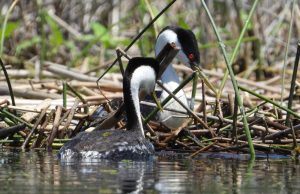 important bird species.
important bird species.
In 2010, the Redbud Audubon Society began a long-term project to monitor Western and Clark’s Grebes, two striking waterbirds known for their floating nests and elegant courtship displays. For over a decade, volunteers have counted these nests by canoe — a rewarding but time-consuming effort.
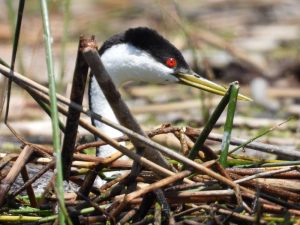 DDD (a derivative of DDT) and DDT had devastating impacts on Clear Lake’s grebe populations, and their story is one of the most well-known early examples of pesticide-driven ecological collapse in the U.S. Rachel Carson’s Silent Spring (1962) mentions this specific case as a warning of how unchecked pesticide use can disrupt ecosystems.
DDD (a derivative of DDT) and DDT had devastating impacts on Clear Lake’s grebe populations, and their story is one of the most well-known early examples of pesticide-driven ecological collapse in the U.S. Rachel Carson’s Silent Spring (1962) mentions this specific case as a warning of how unchecked pesticide use can disrupt ecosystems.
What Happened at Clear Lake?
In the 1940s and 1950s, Clear Lake in California was heavily treated with DDD (also called TDE)—a chemical cousin of DDT—to control gnat populations, especially the Clear Lake gnat (Chaoborus astictopus), a non-biting midge considered a nuisance to tourism.
Timeline of Pesticide Use and Grebe Decline:
- 1949 – Clear Lake was first treated with DDD.
– Immediate success against gnats, but…
– Fish and bird die-offs were soon observed. - 1954–1957 – DDD treatments continued.
– DDD, being fat-soluble, bioaccumulated in fish and biomagnified up the food chain.
– Western Grebes, top predators in the aquatic system, ingested large amounts via contaminated fish. - Bird Deaths:
– Grebes began to die in alarming numbers.
– Some grebes laid eggs, but the eggshells were thin and often broke before hatching.
– Chick survival dropped drastically.
– Local extinction-level declines in grebe populations were recorded. - 1960s – DDD use at Clear Lake was stopped, but residues remained in the sediment and biota for decades.
How DDD/DDT Hurt Grebes: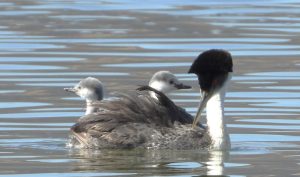
- Bioaccumulation: Grebes eat fish, which had absorbed DDD from plankton and insects.
- Eggshell thinning: DDT/DDD interferes with calcium metabolism, causing fragile eggs.
- Sterility and embryo death: Pesticide exposure affected reproduction.
- Liver and nervous system damage: In adult birds, often leading to death.
In Silent Spring, Carson wrote: “At Clear Lake in California, a program of chemical control of the gnat population had been carried out using DDD… Although the gnat population returned after a time, the grebes—birds that dived for fish—almost disappeared. The insecticide, though barely detectable in water, accumulated in fish and then in the grebes.”
She used Clear Lake as a case study of long-term, ecosystem-wide consequences of pesticide use, despite initial short-term success.
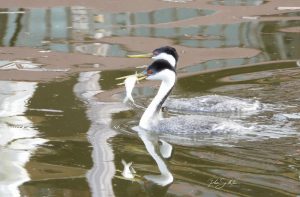 Now, thanks to a grant from the National Audubon Society’s Audubon-in-Action program, Redbud Audubon is launching a cutting-edge new phase of this work. The project, powered by drones and artificial intelligence, will collect data faster, more efficiently, and in ways never possible before.
Now, thanks to a grant from the National Audubon Society’s Audubon-in-Action program, Redbud Audubon is launching a cutting-edge new phase of this work. The project, powered by drones and artificial intelligence, will collect data faster, more efficiently, and in ways never possible before.
The grant funded the purchase of drones, batteries, licensing, and binoculars, but its impact goes far beyond equipment. It has sparked a unique collaboration between scientists, teachers, students, and local tribal environmental groups.
Pacific Union College adjunct professor Dr. Scott Butterfield, along with biologist Dr. Floyd Hayes, associate professor Aime Wyrick-Brownsworth, and project coordinator Donna Mackiewicz — who also serves as president of the Redbud Audubon Society — are leading the project.
Over the next five years, their goal is to develop and refine drone- and AI-based methods for tracking grebe colonies and assessing the health of Clear Lake. Even more exciting: the research will be embedded into the curriculum at Upper Lake and Lower Lake High Schools and tribal environmental programs.
High school and tribal students will gain hands-on experience working alongside Pacific Union College students — from designing the research to collecting and analyzing data, all the way to publishing results. It’s a rare opportunity to participate in real-world science and conservation.
Recently, Dr. Butterfield and Mackiewicz brought the project into classrooms, reaching more than 250 students. The effort culminated in a field trip to the Rodman Slough and nearby reclamation ponds — one of 37 known grebe nesting sites on the lake. District 4 Supervisor Brad Rasmussen joined the outing, along with science teacher Robert Keen and his students from Upper Lake High School.
Students learned to distinguish between Western and Clark’s Grebes, watched courtship behaviors like “rushing” — where birds run side-by-side across the water — and heard how researchers are working to protect nesting sites threatened by human disturbance and environmental decline.
When additional funding comes through ( on hold like so many programs today), the project is set to launch fully into classrooms and out onto the lake next year.
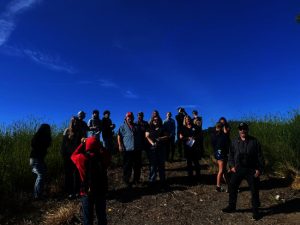 “The students are excited about the project and we’re looking at a variety of ways to keep them involved,” said Mackiewicz. “We’re planning before- and after-school clubs, in-school activities, civic volunteer hours, and full integration into the classroom curriculum. Grebe nesting season runs from May through September, so we’ll all be ready to monitor all 27 sites around the lake.”
“The students are excited about the project and we’re looking at a variety of ways to keep them involved,” said Mackiewicz. “We’re planning before- and after-school clubs, in-school activities, civic volunteer hours, and full integration into the classroom curriculum. Grebe nesting season runs from May through September, so we’ll all be ready to monitor all 27 sites around the lake.”
For those who want to support this important effort, donations and inquiries are welcome at:
Redbud Audubon Society
P.O. Box 5780
Clearlake, CA 95422
Phone: (707) 805-9410
Email: redbud.audubon@gmail.com
With help from science, students, and a little technology, the grebes of Clear Lake may have a brighter — and more closely monitored — future ahead.
